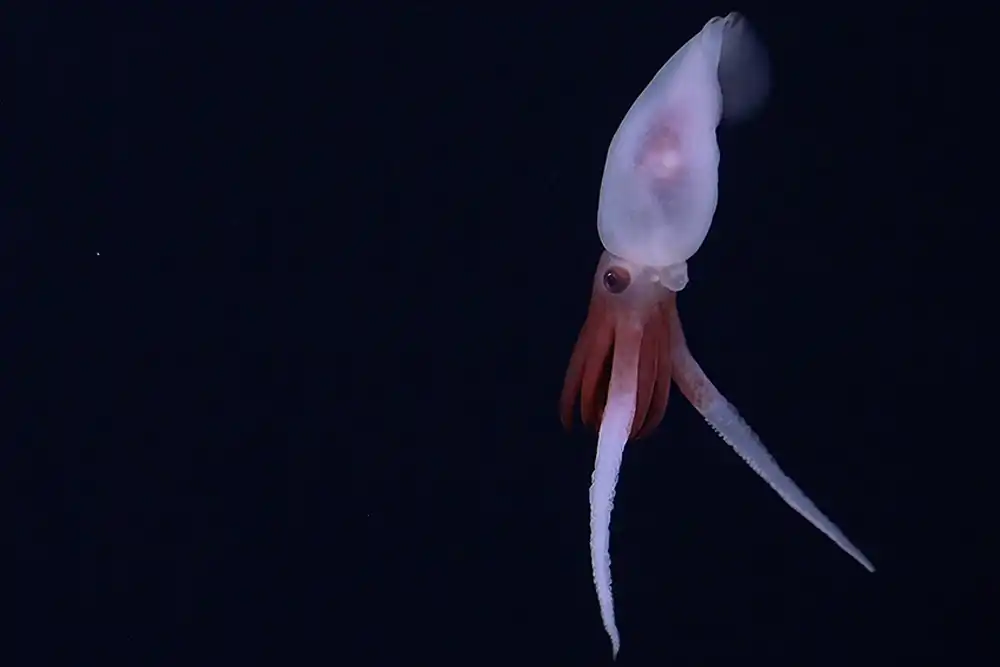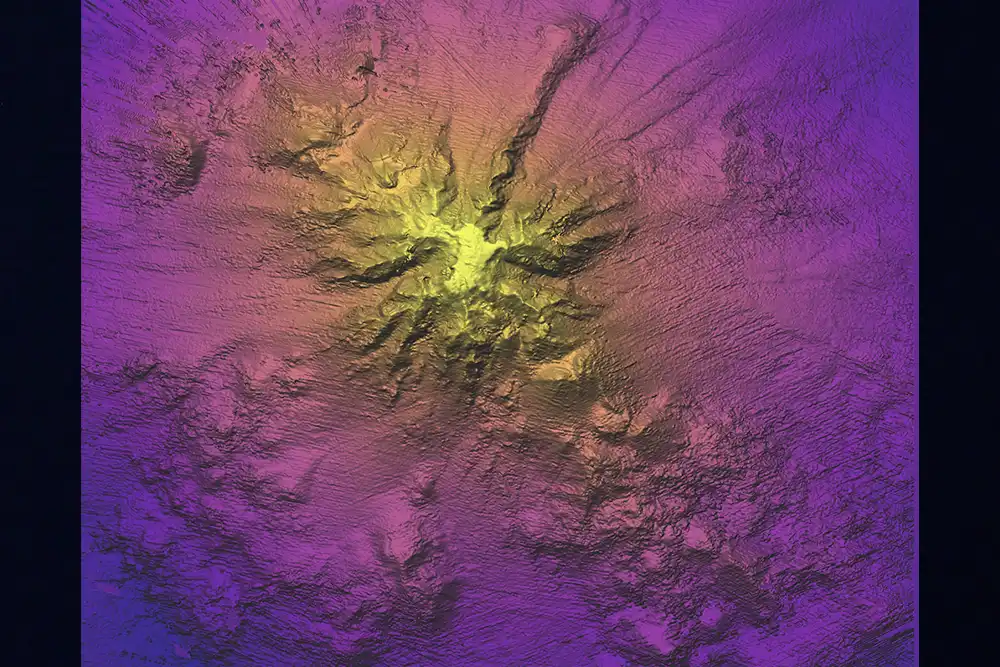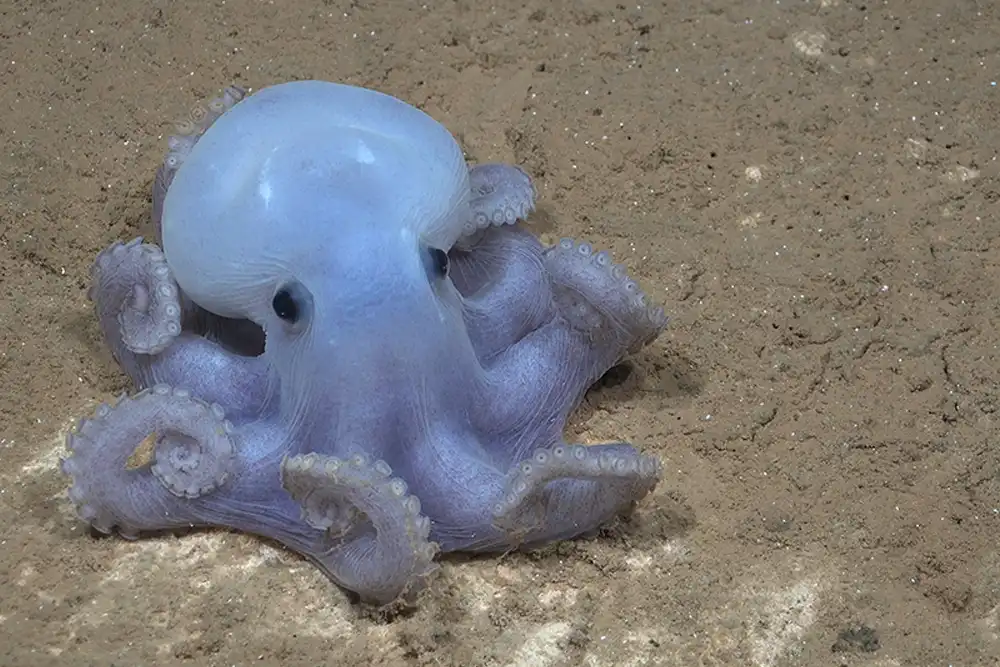
The Schmidt Ocean Institute’s latest expedition to the Nazca Ridge, an underwater Pacific mountain chain located approximately 1450km (900 miles) off the coast of Chile, has turned up at least 20 new species and an entirely new seamount.
The Nazca Ridge and the adjoining Salas y Gómez Ridge are under consideration for designation as a High Seas marine protected area, part of the United Nations High Seas Treaty to ensure the conservation of vitally important habitats located in international waters.
The discoveries – which include the first-ever recording of a rare species of squid and thriving deep-sea coral reefs – were made during a 28-day expedition conducted from the Schmidt Ocean Institute’s Research Vessel Falkor (too), accompanied by the Institute’s remotely operated deep-sea exploration vehicle, ROV SuBastian.
The newly discovered seamount covers an area of approximately 70 sq km, reaching a depth of 994m at the peak from its base of 4,103m – a total height of 3,109m, or 1.9 miles above the ocean floor.

The scientists reported it is home to ‘a thriving deep-sea ecosystem’, including extensive sponge gardens and wide expanses of ancient corals – a pristine coral garden covering an area of approximately 800 sq m was found to provide shelter for an array of organisms such as rockfish, brittle stars, and king crabs.
One highlight of the expedition was the first recorded footage of a Promachoteuthis squid, a genus so rare that only three species have so far been described, based on just a handful of samples found in fishing nets, some of which date back to the late 1800s.
The team also documented a Casper octopus, the first time the species – which remains undescribed as no sample has yet been collected – has been seen in the Southern Pacific. Also spotted were two rare Bathyphysa siphonophores (colonial organisms comprised of many individuals), which were nicknamed ‘flying spaghetti monsters’ by the commercial divers who first observed them.

The expedition was Schmidt Ocean Institute’s third exploration of the Nazca and Salas y Gómez and Ridges in 2024. Expeditions in January and February documented more than 150 previously unknown species and observed many others in that location for the first time, increasing the number of species known to inhabit the region from 1,019 at the start of 2024 to more than 1,300 – a figure which is likely to grow.
‘Upon concluding our third expedition to the region, we’ve explored around 25 seamounts on the Nazca and Salas y Gómez Ridges,’ said Co-Chief Scientist and Schmidt Ocean Institute Marine Technician, Tomer Ketter.
‘Our findings highlight the remarkable diversity of these ecosystems, while simultaneously revealing the gaps in our understanding of how the seamount ecosystems are interconnected. We hope the data gathered from these expeditions will help inform future policies, safeguarding these pristine environments for future generations.’
The expedition was undertaken in partnership with the Nippon Foundation-Nekton-led Ocean Census alliance, a collaborative project to accelerate the identification of new ocean species using novel scientific methods, with the aim of discovering 100,000 new ocean species by 2030.

‘The seamounts of the Southeastern Pacific host remarkable biological diversity, with species found nowhere else to date,’ said Prof Alex David Rogers, Science Director of Ocean Census.
‘The work our taxonomists have conducted aboard Falkor (too), supported by Schmidt Ocean Institute team, will significantly enhance our understanding of the distribution of remarkable life forms on these underwater mountains, including several that have never before been mapped or seen by human eyes.’
High-resolution mapping of the seamount was conducted by a team of hydrographers from the Center for Coastal and Ocean Mapping/Joint Hydrographic Center at the University of New Hampshire. The seafloor data will be included in the Nippon Foundation-GEBCO Seabed 2030 Project, a global initiative to map the entirety of the ocean floor by 2030.
‘This was the first mission led by the staff and crew of Schmidt Ocean Institute, with wonderful colleagues from a number of organizations on board, and I was privileged to be among the scientists joining the research vessel remotely,’ said Co-Chief Scientist and Schmidt Ocean Institute Executive Director Dr Jyotika Virmani.
‘The discovery of a new seamount almost 2 miles tall – almost four times as tall as the Burj Khalifa – with a vibrant ecosystem was very exciting. Only 26 per cent of the seafloor has been mapped to this high resolution and each expedition on Falkor (too) brings into focus a little more of the unknown seabed and life on our home planet.’


